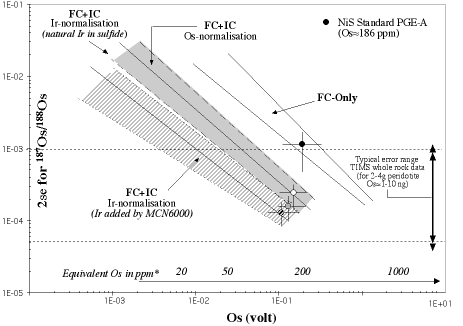Pearson, N.J., Alard, O., Griffin, W.L., Graham, S. and Jackson, S.E., GEMOC Macquarie
The Re-Os isotopic system is widely used to study the timing and nature of melting and metasomatism in the lithospheric mantle. Petrographic and microanalytical data show that essentially all of the Os, and most of the Re, in mantle peridotites is concentrated in sulfides. Two types of sulfide occur in mantle samples (Alard et al., 2000): (1) silicate enclosed Ni-rich monosulfide solid solutions enriched in Os+Ir and having Pd/Ir<1; (2) interstitial Cu-rich S-poor sulfides depleted in Os+Ir and relatively enriched in Pd±Pt. The mixture of these two types has major implications for interpretation of whole-rock PGE and Re-Os data.
A technique has been developed for the in-situ measurement of Os isotopes
in sulfides using a Merchantek LUV266 laser microprobe and a Nu Plasma
multi-collector ICP-MS with 12 Faraday cups and 3 ETP ion counters.
We use two combinations of collectors:
Masses 194, 192, 190, 189,
188, 187, 186, 185 in Faraday cups
Masses 194, 193, 192, 191,
190, 189, 188, 186 in Faraday cups; 187 and 185 in ion counters.
Mass discrimination is corrected by normalisation of 189Os/192Os =0.39593 for measurements with the Faraday array. The mixed Faraday-ion counter setup allows the use of 191Ir/ 193Ir for this correction, using either (1) the Ir in the sulfide; (2) addition of Ir to the nebuliser gas as a Ždry' vapour from a CETAC MCN6000. Analysis of an Os standard spiked with Ir shows that this procedure gives the correct Os isotope ratios. The overlap of 187Re on 187Os is corrected using a 187Re/185Re = 1.6723, determined iteratively by repeated measurements of an Os standard spiked with Re. Typical precision (±2se) for analysis of a 25ppb Os solution is ±0.0002 for the Faraday setup and ±0.00005 for the combined Faraday-IC setup. The accuracy of the Re correction can be demonstrated up to 187Re/188Os = 1.6 using the Faraday array and up to 187Re/188Os = 0.26 using the Faraday-IC setup. Typical precision on 187Os/188Os with 187Re/188Os = 0.26 is ±0.0001 (2se).
Repeated LAM analysis of a synthetic NiS bead with 200ppm Os demonstrates
the precision expected for peridotite sulfides as a function of signal
intensity, laser spot size and analysis duration (Fig. 1). Precision
equivalent to N-TIMS is achieved using the Faraday array for Os > 200ppm
and the Faraday-IC setup for Os > 50ppm. Better precision is obtained
when Ir is used to correct for mass discrimination.

Figure.1:Precision on 187Os/188Os (±2se) versus Os signal intensity.
ŽEquivalent Os in ppm*' relates Os signal and Os concentration as measured
by LAM ICPMS. FC = faraday cup; IC = ion counter
Three sulfide inclusions in olivine macrocrysts (%Fo>92) derived from disaggregated peridotites from Udachnaya Pipe (Siberia, Russia) have 187Os/ 188Os from 0.1072-0.1118 and 187Re/188Os of 0.006-0.081. TRD ages vary from 3.6-2.3 Ga and TMA from 2.9-3.6 Ga. These ages are equivalent to the oldest TRD model ages (3.0-3.2 Ga) obtained by conventional analysis of Udachnaya peridotite xenoliths (Pearson et al., 1995), and agree well with Re-Os data for three sulfide inclusions in a single diamond from the same pipe ( 3.1 to 3.5 Ga; Pearson et al., 1999).
Several large (50-200 um) sulfide inclusions from olivine macrocrysts (Fo92), peridotite xenoliths and diamonds from the Lac de Gras area (Slave Craton, Canada) yielded 187Os/188Os from 0.1080-0.1131 (TRD ages =3.0-2.1 Ga, TMA = 2.6-3.3 Ga). These ages are equivalent to the oldest model ages (3.1 Ga) reported for xenoliths in the nearby Jericho pipe (Irvine et al., 1999).
Enclosed sulfides in peridotite xenoliths in alkali basalts (Mt. Gambier, S. Australia) give model ages within uncertainty of the 1.9 Ga model ages obtained by Handler et al. (1998) for the same locality. Interstitial sulfides give modern asthenosphere 187Os/188 Os; these rocks contain two generations of sulfides with different Os isotopic compositions and Re/Os ratios.
With current technology, the best results are obtained from sulfide
grains *50 µm in diameter with Os contents *40 ppm. These data
have a precision equivalent to N-TIMS data on whole rock samples.
The lower-precision data obtained on low-Os interstitial sulfides are still
very useful in understanding the movement of Os within the lithosphere
(Alard et al., this volume). The major advantage of the LAM-MC-ICPMS technique
lies in providing in-situ analyses with the spatial and microstructural
context required for meaningful interpretation. The application of this
technique will make Re-Os analysis of mantle-derived rocks more rapid and
less expensive, and enable larger-scale surveys of the age structure of
the continental lithosphere.
REFERENCES :
Alard O., Griffin WL, Lorand JP, Jackson SE & O'Reilly SY, 2000. Non-chondritic distribution of the highly siderophile elements in mantle sulfides.Nature, submitted.
Handler MR, Bennett VC & Esat TM 1997. The persistence of off-cratonic lithospheric mantle: Os isotopic systematics of variably metasomatised southeast Australian xenoliths. Earth Planet. Sci. Lett. 151, 61-75.
Irvine GJ, Kopylova MG, Carlson RW, Pearson DG, Shirey SH & Kjarsgaard BA 1999. Age of the lithospheric mantle beneath and around the Slave Craton: A Re-Os isotope study of peridotite xenoliths from the Jericho and Somerset Island kimberlites. Ext. Abst. 9th Goldschmidt Conf.
Pearson DG, Shirey SB, Carlson RW, Boyd FR, Pokhilenko NP & Shimizu N 1995. Re-Os, Sm-Nd and Rb-Sr isotope evidence for thick Archaean lithospheric mantle beneath the Siberian craton modified by multistage metasomatism. Geochim. Cosmochim. Acta 59, 959-977.
Pearson DG, Shirey SB, Bulanova GP, Carlson RW & Milledge HJ 1999. Re-Os isotope measurements of single sulfide inclusions in a Siberian diamond and its nitrogen aggregation systematics. Geochim. Cosmochim. Acta 63, 703-711.

 GEMOC ARC National Key Centre
GEMOC ARC National Key Centre